Freelance curator Patricia Fleming has established many significant artist-led initiatives in Scotland Including Fly 1996-1999 (now Market Gallery) and Fuse. Fuse provided free studios and stipends to over 500 artists from 1992-1999 including Martin Boyce, Jacqueline Donachie, Douglas Gordon and Jim Lambie. Fleming was the first curator for Wales at the Venice Biennale in 2003, and produced A Gathering Space – Scotland’s presentation at the 11th International Architecture Exhibition at the Venice Biennale 2008 with Hoskins Architects and The Lighthouse. She now runs Patricia Fleming Projects, a contemporary art gallery in Glasgow. Patricia gives her pick of what to see at this year’s Venice Biennale.
Another Venice Biennale (the 120th anniversary) and another internationally respected curator sets the scene; this time it’s Okwui Enwezor. For me, every time, this cycle of world-class research is impressive. Not everyone has the capacity to travel (literally or conceptually); therefore the engagement with art and artists from other countries and cultures is precious. When art resonates beyond its edges, it starts conversations with us, beyond its surroundings and between people. In the context of the Biennale the capacity to bring global thinking to life is intensified by its sheer volume, collective spirit and gravity. This year’s title All The World’s Futures is so vast in its reluctance to be pinned down that I’m seeking solid ground before the adventure begins.
After a slightly underwhelming start in the Arsenale, Enwezor is relentless in the inclusion of artists from countries the predominately Western art world has regularly overlooked. I found myself looking for a breathing space in a journey through an evolving story with too many voices and issues to grasp.
Halfway down the Arsenale, Katharina Grosse’s ‘Untitled Trumpet’ heralded its arrival. A single immersive experience created by drapes falling to a rubble-covered floor, spray paint blurring the space between sculpture and backdrop. Here I was transported to a future where the art of our time lay shattered and trampled. Images of Isis destroying ancient temples and the violence the earth does to her self raced through my head. The pause was quickly filled by an acknowledgement that no matter what we try to do, no matter how clever we think we are events and actions repeat a cycle out-with our control.
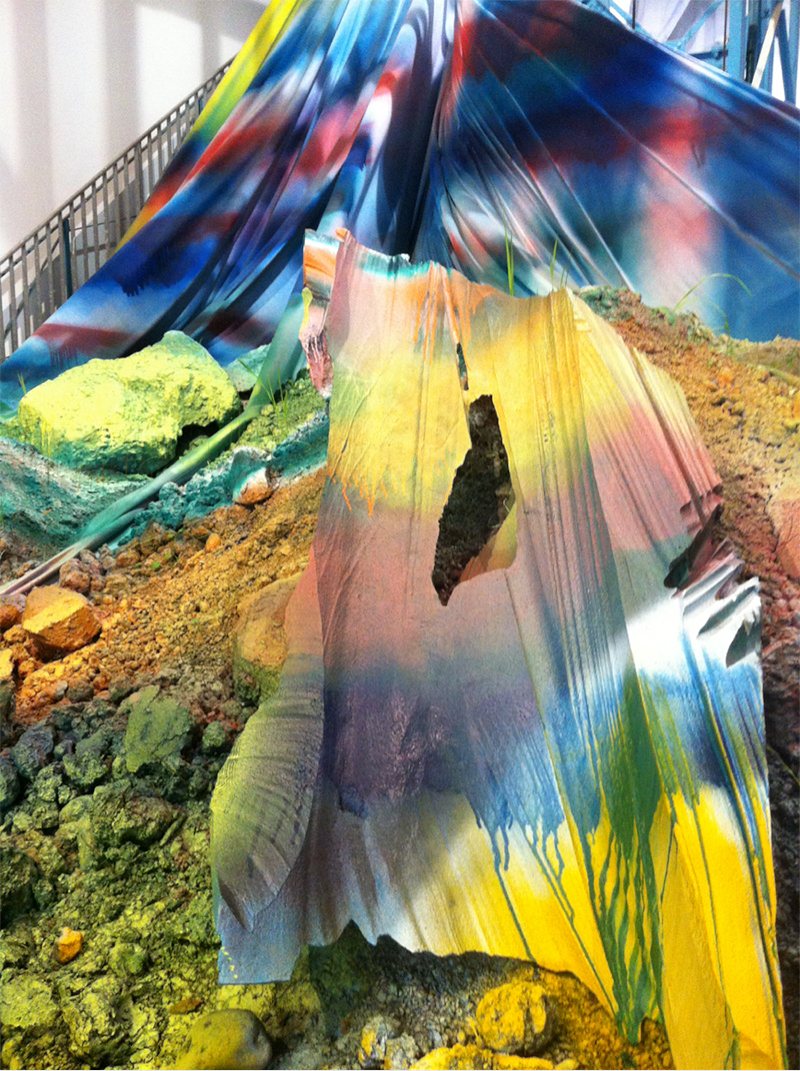
Katharina Grosse ‘Untitled Trumpet, 2015 (taken at ‘All The World’s Futures’, La Biennale di Venezia 2015)
The art world isn’t ‘even’ or ‘fair’ but I am pretty sure there is commonality in the hopes and dreams of artists working across the globe. Trying to be an artist and maintaining a practice whither in Glasgow or Mozambique is challenging, just in different ways. Regardless, ideas are made visible often with the tools closest to you and the push and pull of artistic communities the world over continues and refreshes. The difference brings a variety of voices, opinions or just things you hadn’t thought of (maybe before the internet).
Looking to the past is necessary to critique the present, but I couldn’t help feeling that those shaping the way we really might or might not read the future were missing. I kept asking myself what ‘All the World’s Futures’ would have delivered, if the same unapologetic research and inclusion of lesser known artists, like (new to me) Goncalo Mabunda, a sculptor who lives and works in Maputo, had been applied to the selection of artists from ‘western’ countries. Instead, the same western ‘names’ from well-worn routes across familiar art territory only added to my uneasy feeling, but maybe that was the point. In my anticipation, I think I expected too much of Enwezor’s Biennale. Although it does feel like a new platform has been crafted and Enwezor dares us to address its fragile condition, however, its identity is a long way off. Enwezor’s presented 136 artists across the Arsenale and Italian Pavilion, eighty-eight of whom are in the Biennale for the first time. To experience this amount of new art in one place is a privilege and the inclusion of more artists from countries previously overlooked made me pay more attention to work I have been guilty of walking past before. Did it make me think about all the world’s futures?
The highlights have been poured over in the art press already. Joan Jonas’s They Come to Us was ‘haunting’ (in a good way). On my return I am surprised by the lack on images on my phone. In the Gardini, I took more images of the spectacle of the new Australian Pavilion designed by Denton Corker Marshall sitting in its precarious setting and wondered what it will look like as a swimming pool in 2016 at The Architecture Biennale. It would be great if the pool could be kept for the Sant’ Elena community, but that’s not going to happen. Will the cantilever act as a diving board? Oh God, swimwear to add to the what to pack-for-Venice-dilemma! We did encounter the best-trained gallery assistant ‘ever’ inside, which, given the building works and a huge install, the attention to detail and preparedness of the staff was one of my highlights. I loved roving about the Gardini but this year my standout exhibitions were in the Collatorale section.
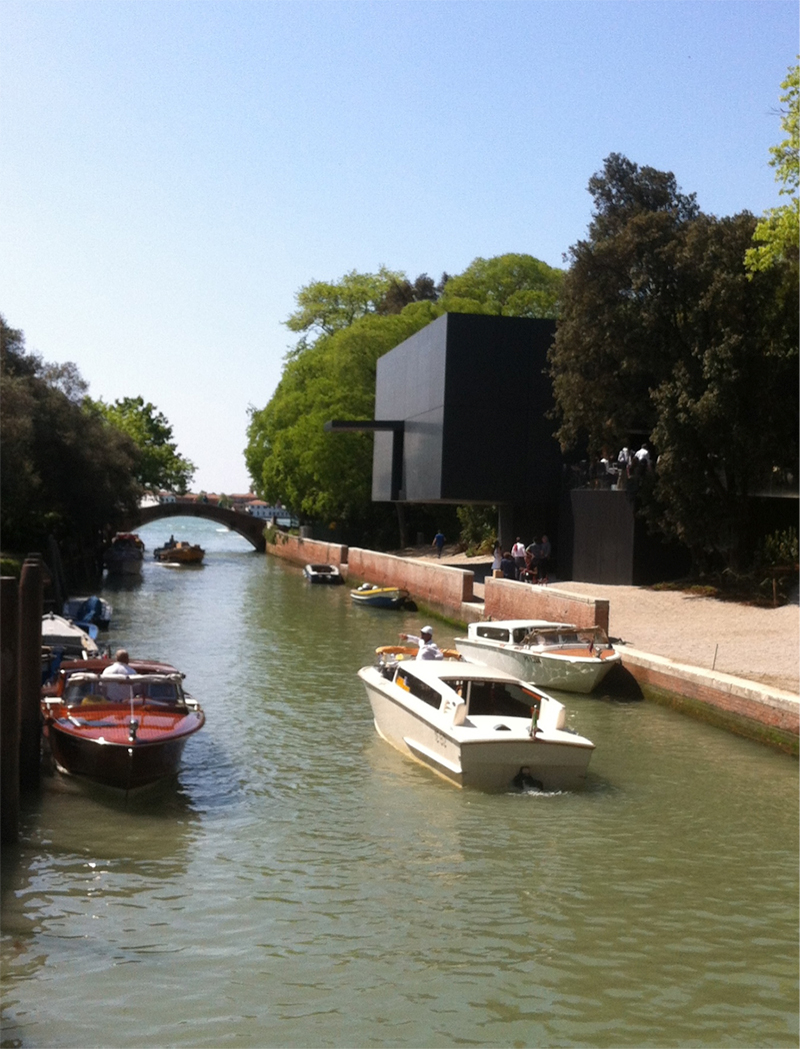
New Australian Pavilion (Gardini, Venice) designed by Denton Corker Marshall
Lucy Byatt Director at Hospitalfield has sensitively curated Graham Fagan’s* outstanding new work at Palazzo Fontana. In it, the work of Ayrshire poet Rabbie Burns is cast as a powerful catalyst to confront Scotland’s participation in the slave trade. The venue’s balcony overlooks the Grand Canal connecting the water, the architecture and the exhibition to Venice. Reggae singer Ghetto Priest’s slow repetitive channeling of Burn’s poem The Slave’s Lament lingers like dappled sun on the canal following a route to those dark days. This made me wonder if Enwezor could have revealed more about the slave trade today, the impact on communities and the different ways it exists in our cities and towns. As the canal follows eventually to the Mediterranean, thoughts of what type of future the people risking their lives in small boats hope for and what we can do to help. A future to be safe, to be able to feed your family and not be used by another should be the right of everyone.
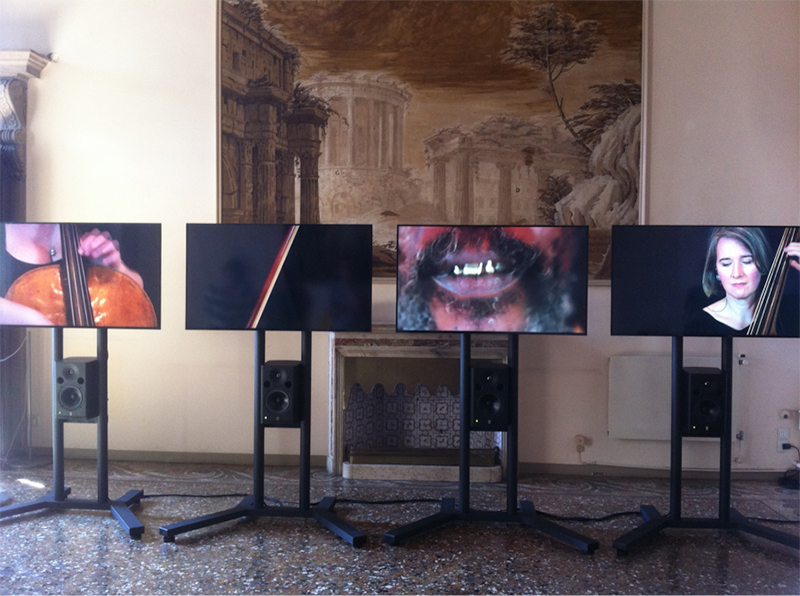
Graham Fagen: Scotland + Venice, 2015 (taken at ‘All The World’s Futures’, La Biennale di Venezia 2015)
The afternoon was spent in the Querini Stampalia where Jimmie Durham’s sculptures nuzzled affectionately with Carlo Scarpa’s architecture in the basement gallery. This must be one of the best art and architecture pairings I’ve seen to date, not only in its appeal for all ages but in the sheer joy of being invited into Durham’s imagination, alongside the precision of Scarpa’s details.
As the sunset over our time in Venice, our group shared Biennale chatter. I voiced my perplexity over the inclusion of Georg Baselitz and one of our party chipped in that they had overheard an American family in front of the oversized paintings say: ‘Where would we put it?’ to which the Dad replied: ‘in the museum’.
I’m hopeful that my questions are left unanswered here, but ‘fair’ or not what is clear is that ‘All the World’s Futures’ are our collective responsibility.
*Read more about Graham Fagen’s Venice exhibition on Central Station here. Matt’s Gallery who represent Graham have just released 150 editions of 10″ signed records of The Slave’s Lament available to purchase here via the Own Art scheme.
The Venice Biennale continues until 22 November. Patricia highly recommends a visit and you can now get affordable flights from Edinburgh. Visit www.labiennale.org for more information.
All images courtesy Patricia Fleming Projects, Glasgow.
More: Website | Vimeo | Twitter
//////
Looking for more articles? Visit here.


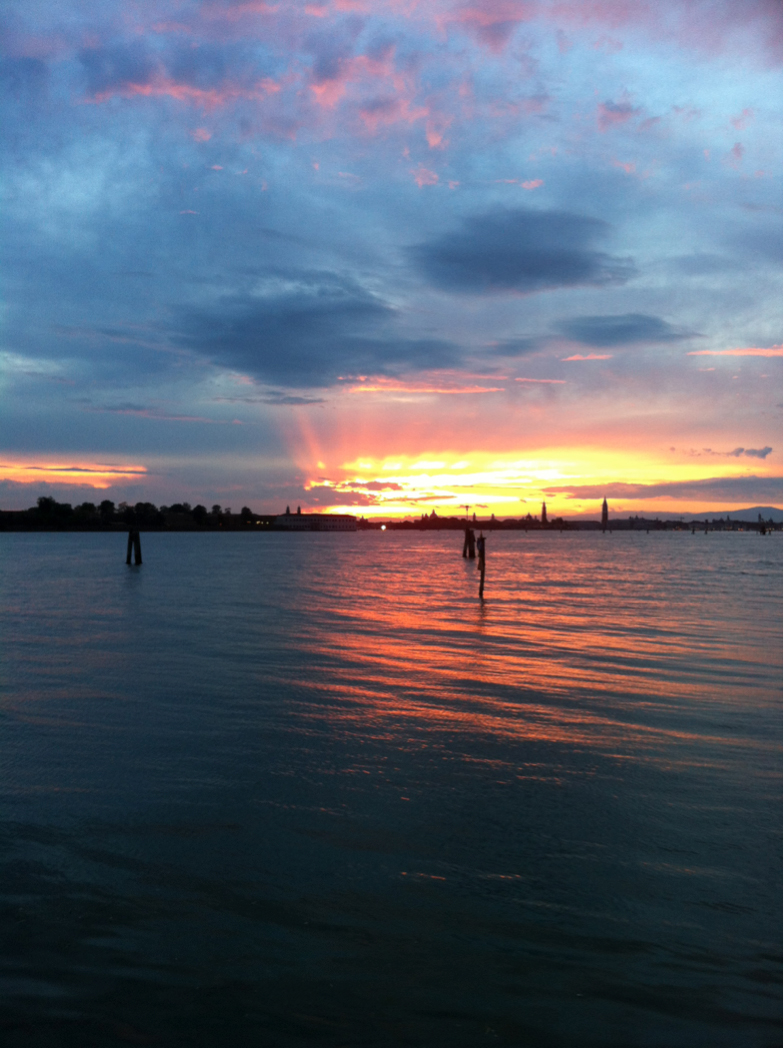
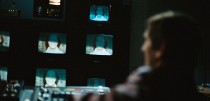











Comments